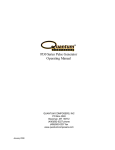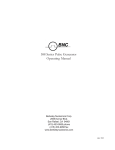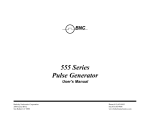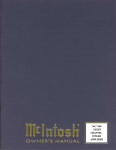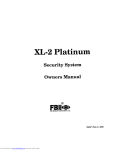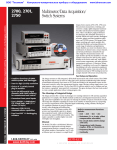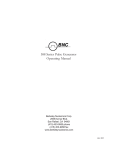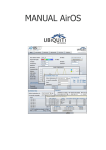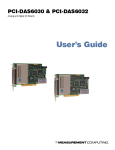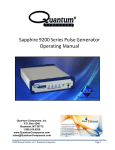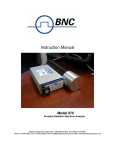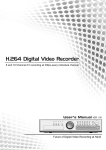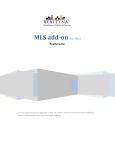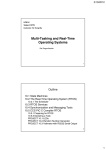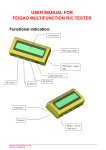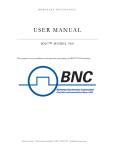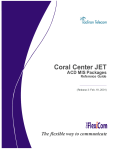Download Manual - Berkeley Nucleonics Corporation
Transcript
505 Pulse Generator Operating Manual Berkeley Nucleonics Corporation 2955 Kerner Blvd. San Rafael, CA 94901-5418 (415)453-9955 phone (415)453-9956 fax www.berkeleynucleonics.com May 2005 Contents 1 Introduction................................................................ 1 Technical Support ..............................................................................................2 Warranty .............................................................................................................2 Package Contents ..............................................................................................2 Safety Issues .......................................................................................................3 2 Front Panel Overview ............................................... 5 505 Front Panels ...............................................................................................6 Display Layout and Indicators ...................................................................................................... 6 Keypads .............................................................................................................................................. 6 3 Pulse Concepts & Pulse Generator Operation ...... 9 Counter Architecture Overview ..................................................................................................10 System Timer Functions ...............................................................................................................10 Channel Timer Functions ............................................................................................................11 Dependent & Independent Timing Events ...............................................................................11 Selecting Menus..............................................................................................................................11 Numeric Input Mode ......................................................................................................................12 Entering Numeric Parameters ....................................................................................................12 Selecting Menu Parameters ...........................................................................12 Enable/Disable Pulse Output .......................................................................................................12 Setting Pulse Sync Source ............................................................................................................12 Setting Pulse Gate Control ............................................................................12 Configuration # ...............................................................................................................................13 Storing a Configuration ................................................................................................................13 Recalling System Configurations ...............................................................................................13 Setting System Mode of Operation .............................................................................................13 Enabling External Gate Control .................................................................................................13 Power On Configuration ...............................................................................................................14 Setting Auto Start Mode ...............................................................................................................14 Setting System Serial Port Baud Rate ......................................................................................14 Setting Communication GPIB Address .....................................................................................14 Setting Communication Echo Mode ...........................................................................................14 Setting Key Repeat Rate ...............................................................................................................14 Setting Key and Knob Volume ....................................................................................................14 Setting Pulse Timing Parameters ..............................................................................................15 Setting Pulse Output Parameters ...............................................................................................15 Setting Pulse Mode of Operation .................................................................................................15 Delaying the Start of Channel Output ......................................................................................15 Rearming the Channel Timers ....................................................................................................15 Setting Pulse Gate Control ..........................................................................................................16 Setting the System Internal Rate Generator ..........................................................................16 Setting System Mode of Operation ............................................................................................16 Enabling System Trigger or Gate ...............................................................................................16 Power On Configuration ...............................................................................................................16 Setting Auto Start Mode ...............................................................................................................16 4 505 Menus.................................................................. 17 505 Menu Structure ........................................................................................18 CHANNEL Menu ...........................................................................................................................18 MODE Menu ....................................................................................................................................18 TRIG/GATE Menu .........................................................................................................................18 SYSTEM Menu ...............................................................................................................................19 SETUP Menu ..................................................................................................................................19 5 Operating the 505 .................................................... 21 Quick Start - Normal Internal Rate Generator Operation ........................22 Quick Start - Normal External Trigger Operation ......................................22 System Timer Overview ..................................................................................23 To Use Continuous Mode ..............................................................................................................23 To Use Single Shot Mode ..............................................................................................................23 To Use Burst Mode .........................................................................................................................23 To Use Duty Cycle Mode ...............................................................................................................24 Channel Timer Overview ...............................................................................24 To Use Normal Mode Function ....................................................................................................24 To Use Channel Single Shot Function ......................................................................................24 To Use Channel Burst Mode Function ......................................................................................25 To Use Channel Duty Cycle Function .......................................................................................25 To Use the Channel Gating Function ........................................................................................25 External Input Overview ................................................................................25 To Generate a Pulse on Every Trigger Input ..............................................26 To Generate a Burst of Pulses on Every Trigger Input .............................26 To Start a Continuous Stream of Pulses Using the External Trigger .....26 To use the External Gate to Control the System ........................................27 6 Programming the 505 .............................................. 29 Talking to the Pulse Generator .....................................................................30 RS232 Interface Overview ..............................................................................30 GPIB Interface Overview ...............................................................................30 Programming Command Types and Format ...............................................31 IEEE 448.2 Common Command Format .....................................................31 SCPI Command Keywords .............................................................................31 SCPI Command Format .................................................................................31 SCPI Query Format .......................................................................................................................31 SCPI Keyword Separator ...............................................................................32 SCPI Optional Keywords ................................................................................32 SCPI Specific and Implied Channel .............................................................32 SCPI Parameter Types ...................................................................................32 Error Codes .......................................................................................................33 Programming Examples .................................................................................33 505 SCPI Command Summary .....................................................................34 505 SCPI Command Summary .....................................................................35 505 SCPI Command Summary .....................................................................36 505 SCPI Command Summary .....................................................................37 IEEE 488.2 Common Commands .................................................................38 Appendix ...................................................................... 39 Appendix A - Specifications ...................................... 40 505 Specifications ............................................................................................40 1 Introduction 1 Introduction This manual is a reference designed to familiarize you with the Berkeley Nucleonics 505 pulse generator and is arranged so that you can easily find the information you’re looking for. Generally, each topic has its own section, and no section assumes that you’ve read anything else in the manual. Technical Support For questions or comments about operating the 505 -- our technical staff can be reached via one of the following methods: - Phone - (415)453-9955 - Fax - (415)453-9956 - Internet - www.berkeleynucleonics.com Warranty In addition to a 30-day money back guarantee, the 505 has a one-year limited warranty from the date of delivery. This warranty covers defects in materials and workmanship. Berkeley Nucleonics will repair or replace any defective unit. Contact us for information on obtaining warranty service. Package Contents The box you receive should contain the following: - 505 Pulse Generator - AC Power Cord - User’s Manual Contact Berkeley Nucleonics (415-453-9955) if any parts are missing. 2 Safety Issues Normal use of test equipment presents a certain amount of danger from electrical shock because testing must be performed where exposed voltage is present. An electrical shock causing 10 milliamps of current to pass through the heart will stop most human heartbeats. Voltage as low as 35 VDC or RMS AC should be considered dangerous and hazardous since it can produce a lethal current under certain conditions. Higher voltages pose an even greater threat because such voltage can easily produce a lethal current. Your normal work habits should include all accepted practices that will prevent contact with exposed high voltage, and steer current away from your heart in case of accidental contact with a high voltage. You will significantly reduce the risk factor if you know and observe the following safety precautions: • If possible, familiarize yourself with the equipment being tested and the location of its high-voltage points. However, remember that high voltage may appear at unexpected points in defective equipment. • Do not expose high voltage needlessly. Remove housing and covers only when necessary. Turn off equipment while making test connections in highvoltage circuits. Discharge high-voltage capacitors after shutting down power. • When testing AC powered equipment, remember that AC line voltage is usually present on power input circuits, such as the on-off switch, fuses, power transformer etc. • Use an insulated floor material or a large, insulated floor mat to stand on, and an insulated work surface on which to place equipment. Make certain such surfaces are not damp or wet. • Use the time-proven “one hand in the pocket” technique while handling an instrument probe. Be particularly careful to avoid contact with metal objects that could provide a good ground return path. • Never work alone. Someone should always be nearby to render aid if necessary. Training in CPR first aid is highly recommended. 3 4 2 Front Panel Overview 5 Front Panel Overview BNC 505 Front Panels Display Layout and Indicators A 2 line x 16 character, backlit LCD display module displays all system parameters and status information. The status information is located in the upper-right corner of the display. There are two enunciators: • Rotating Pie • Vertical Arrow Indicates the unit is actively generating pulses, or armed and waiting for an external trigger. Indicates the function key has been pressed. The upper-left side of the display contains the title of the current menu. The center top line contains the title of the current parameter. The bottom line displays the value of the current parameter. • Power Switch The power switch is located on the lower-right corner of the front panel. Push once to turn the unit on; push again to turn the unit off. Keypads The keypad provides access to the various menus and easy editing of the parameters needed to control the instrument. • Function Key • Next Key • Arrow Keys 6 The system parameters are organized in menus which are accessed by pressing the FUNCTION key and then the appropriate function (yellow labels). All the parameters for one channel are grouped together in the CHANNEL menu. To access additional channels, press the FUNCTION key and then the CHANNEL key (while in the CHANNEL menu) and the menu will increment the channel number. The contents of each of the menus is discussed in detail in section 4 of this manual. The NEXT key provides access to all the parameters in a menu. Pressing the NEXT key selects the next parameter in the currently displayed menu. The up/down arrows are used to increment/decrement the current parameter. For numeric parameters the blinking cursor indicates which digit will be incremented. The right/left arrows are used to change the selected digit for numeric parameters. • Rotary Knob • Channel Outputs • External Input The Rotary Knob may be used to adjust the current parameter as an alternate to the ARROW keypad. The step size is controlled by the position of the cursor. However, turning the knob faster will increase the step size. Pushing the knob performs the same function as pushing the NEXT key, selecting the next parameter in the currently displayed menu. The pulse generator output is available from BNC connectors on the front panel. The output is adjustable from 2V to 20V into a high impedance load. The drive impedance is 50 ohm, so if the load is 50 ohm the output voltage will be one-half of the set voltage. Eight channel units share power supplies between pairs of channels. Four pair of channels, 1 & 5, 2 & 6, 3 & 7, and 4 & 8 share the same voltage supply. The external input provides a trigger and/or gate function for both the system timer and the channel timers. 7 8 3 Pulse Concepts and Pulse Generator Operations 9 Pulse Concepts and Pulse Generator Operation Counter Architecture Overview Arm Gate * Start To Internal System Tim er and S ystem Mode Generator Internal To Pulse RUN Command External Input Start Gate ** Arm Channel Timers and Channel Mode Generators Output MUX Output Pulses * Start source is: RUN button in Internal Modes in External trigger modes. * Start source is:External RUN buttoninput in Internal Modes External i nput i n E xternal trigger modes ** Channels are armed by the RUN button. In single shot ** Channels are armed by the RUN button. In single s hot and burst modes and burst modes may be rearmed pressing channells channels m ay be r earmed by pressing the R UNby a s econd time. the RUN button a second time. System Timer Functions The System Timer functions as a non-retriggerable, multi-vibrator pulse generator. This means that once started, depending on the mode, the timer will produce pulses continuously. Before pulses will be generated, the timer must be armed and then receive a start pulse. Arming the counter is done by pressing the RUN key. With external trigger disabled, the RUN key also generates the start command for the counter. With external trigger enabled, the external trigger provides the start pulse. In either case, once started, the counter operation is determined by the System Mode Generator. Standard modes include: • • • • Continuous Single Shot Burst Mode Duty Cycle Once started, To pulses are generated continuously. One To pulse is generated for each start command. 'n' To pulses are generated for each start command. Once started, To pulses cycle on and off continuously. The To pulses are distributed to all of the start inputs of the Channel Timers and Mode Generators. 10 Channel Timer Functions The Channel Timer functions as a non-retriggerable, delayed, one shot pulse generator. This means that the timer will only generate one delayed pulse for every start pulse received. Once the channel timer has started counting, additional start pulses will be ignored until the pulse has been completed (nonretriggerable). The start pulse for each channel is provided by the internal To pulse generated by the Internal System Timer. Whether or not a pulse is generated for each To pulse is determined by the Channel Mode Generator. Standard modes include: • Normal • Single Shot • Burst • Duty Cycle A pulse is generated for each To pulse. One pulse is generated at the first To pulse, after which output is inhibited. A pulse is generated for each To pulse, 'n' times, after which output is inhibited. A pulse is generated for each To pulse “n” times, after which the output is inhibited for ‘m’ times. The cycle is then repeated. Different modes may be selected for each output, allowing a wide variety of output combinations. Each output may also be independently disabled or gated (using the external trigger input). Dependent & Independent Timing Events The 505 allows the user to control the relationship between the Channel Timers by setting the sync source for each timer. Independent events are all timed relative to the internal To start pulse. Dependent events may be linked together by setting the sync source to the controlling event. This allows the instrument to match the timed events and adjustments can be made in one event without detuning the timing between it and a dependent event. Selecting Menus Parameters are grouped in menus, selectable using the yellow menu keys. To select the channel parameters press the FUNCTION key and the CHANNEL key. Repeat this process until the desired channel appears. To select other menus press the FUNCTION key and then the key corresponding to the desired function. 11 Numeric Input Mode When the current item is numeric, the system enters the Numeric Input Mode. In this mode data may be edited in one of two ways. Using the arrow keypad, the Left and Right arrow keys are used to select a digit to edit. The selected digit blinks to identify itself as the active digit. The Up and Down arrow keys are then used to increment or decrement this digit. Alternately, after using the Left and Right arrow keys to select an active digit, the adjustment knob may be used to increment and decrement this digit. The adjustment knob features speed dependent resolution. Slow rotation will increment or decrement the active digit by one. As you increase the speed of rotation, the parameter will be 10 to 1000 times faster depending on the speed. Entering Numeric Parameters When the current item is non-numeric, the Up and Down arrow keys are used to select among different options for the parameter. The adjustment knob may also be used to change the selection. If the item is an on-off toggle, the Up arrow (CW adjustement knob) enables the item and the Down arrow (CCW adjustment knob) disables the item. Selecting Menu Parameters Menus include all the parameters for setting up the pulse generator. To select a parameter, within the current menu, press the NEXT key. Pressing the rotary adjustment knob is equivalent to pressing the NEXT key and will also select the next parameter. Enable/Disable Pulse Output Within the CHANNEL menu page to enable or disable the output of an individual timer: • Channel Enables or disables the pulse output for the current channel. Setting Pulse Sync Source Within the CHANNEL menu to set the starting point for the pulse delay parameter: • Sync Set the sync source for the channel, which may be To or any of the other channels. The unit will not allow a channel to trigger itself. Setting Pulse Gate Control • Gate 12 Enables/disables the channel gating using the external trigger input. This function is independent of any other use of the trigger input. Care should be taken to ensure that all uses of the trigger are compatible. To enable the gate, set the gate to active low or active high. Configuration # The configuration # specifies the location to store the current system configuration. Numbers range from 1 to n, where "n" is the number of stored configurations. *NOTE: The number of storage locations is model dependent; see the specifications for your model. You cannot store to the zero location, as that contains the factory default values. • From the Store menu, press the setup button (function + setup). Storing a Configuration Use the following procedure to store a complete system configuration: • Set all parameters to the desired value. • Select a configuration number. Recalling System Configurations Use the following procedure to recall a stored or default system configuration: • Select a configuration number. • From the Recall Menu, press the recall button (function + recall). *Note: Configuration 0 is the factory default setting. Period 0.001s (1kHz) Mode Continuous Trigger Disabled Pulsewidth 0.0002 Delay 0.0 Mode Normal Setting System Mode of Operation • MODE • #/BURST • DC ON • DC OFF Selects the To mode: Continuous, Single Shot, Burst or Duty Cycle mode. Sets the number of pulses to be generated when in the Burst mode. Sets the number of pulses to be generated for each “ON” cycle. Sets the number of pulses to skip for each “OFF” cycle when in the Duty Cycle mode. *NOTE: Any mode may be started by either the RUN key in the internal trigger mode or armed by the RUN key and started by an external trigger in the external trigger mode. In the single shot and burst modes, (internally triggered) the unit disarms itself at the end of the pulse train. Pressing the RUN key after the unit has been disarmed will generate a new pulse train. 13 Enabling External Gate Control • EXTin Selects external input usage for controlling To: disabled, edge triggered or level gated. *NOTE: When the gate disables the System Timer, the timer is reset. The gate edge, to enable the timer, will restart the System Timer, which synchronizes the To pulse to the gate and minimizes jitter relative to the gate. The trigger threshold applies to all uses, channel and system, of the trigger/gate input. Power On Configuration Upon power-up the unit will load the last configuration stored or recalled. If the Autostart mode is enabled, the unit will begin generating pulses after loading the latest configuration. Setting Auto Start Mode • Auto Auto run startup function - allows unit to automatically generate pulses after startup is complete. Setting System Serial Port Baud Rate • Baud Rate Selects the baud rate (within the SYSTEM menu) for the RS232 interface. *NOTE: The unit will not respond to computer commands unless the appropriate BAUD rate or GPIB address is selected. Setting Communication GPIB Address • GPIB Address Selects the GPIB Address (within the SYSTEM menu). Setting Communication Echo Mode • Comm Echo Selects whether to echo characters back to the host computer or not. Setting Key Repeat Rate • Key Rate Sets the rate at which the keys will repeat when held down. This is most useful when using the Up/Down arrows to change parameters. *NOTE: The key repeat rate is fairly accurate (better than one millisecond) and may be used to increase/decrease a parameter at a set rate. 14 Setting Key and Knob Volume • Key Volume • Knob Volume Sets the key click volume. Sets the parameter adjustment knob click volume. Setting Pulse Timing Parameters Within the CHANNEL menu, set the delay until the start of a pulse and the pulsewidth: • Delay • Width Sets the delay from the sync source to the start of the pulse. Sets the width of the active portion of the pulse. Setting Pulse Output Parameters Within the CHANNEL menu, set the pulse polarity and the pulse amplitude (whether the pulse is active high or active low): • Polarity • Amplitude Sets the pulse polarity either active high or active low using the arrow keys or the rotary knob. Sets the pulse amplitude, 2 to 20 volts with a high impedance load. Setting Pulse Mode of Operation Each channel may be set independently to operate in one of four modes: normal, single shot, burst, or duty cycle (within the CHANNEL menu): • Mode • #/Burst • On Cycle • Off Cycle Selects the mode for the current channel. Additional parameters are provided for the burst mode and the duty cycle mode. Sets the number of pulses in the burst mode to generate before inhibiting output. Sets the number of pulses to generate before inhibiting output. Sets the number of pulses to inhibit before repeating the On Cycle. Delaying the Start of Channel Output Within any channel mode, the output of the channel can be delayed using the wait parameter (within the CHANNEL menu): • Wait Sets the number of To pulses to wait until enabling the channel output. Rearming the Channel Timers In the single shot mode and the burst mode the Channel Timers may be rearmed after completing the pulse train by pushing the RUN key again. 15 This allows other channels to be run continuously without interruption while generating individual pulses or a burst of pulses on the single shot or burst mode channels. Setting Pulse Gate Control Enables the use of the external input to gate the channel output (within the CHANNEL menu): • Gate Enables/disables the channel gating using the external trigger. Enables the gate by selecting either active high or active low. This function is independent of any other use of the trigger input. Care should be taken to insure that all uses of the trigger input are compatible. Setting the System Internal Rate Generator Set the internal To period (within the MODE menu): • Period Sets the internal rate generator period. Setting System Mode of Operation Sets the System Timer Mode (within the MODE menu). Enabling System Trigger or Gate Enables the use of the trigger input by the system timer as a trigger source or a gate source (within the TRIG menu): • EXTin • Level • Gate • Edge Selects between disabling the use of the trigger and setting the system trigger mode to trigger or gate mode. Sets the trigger threshold. Selects between active high and active low when the gate mode is selected. Selects between rising edge and falling edge as the trigger source when the trigger mode is selected. Power On Configuration When the unit powers up it will recall the last stored or recalled configuration. Any changes to the configuration which were not saved are not restored. Setting Auto Start Mode The unit may be configured to automatically start generating pulses after power up (within the SYSTEM menu). 16 • AutoStart Disable or enable the autostart feature. 17 18 4 505 Menus 19 505 Menus 505 Menu Structure CHANNEL Menu Channel Sync Delay Width Mode #/Burst On Cycle Off Cycle Wait Polarity Amplitude Gate MODE Menu Period Mode #/Burst On Cycle Off Cycle TRIG/GATE Menu EXTin Level Gate Edge 20 Disable/enable channel output. Select sync source. Sets delay from sync source until pulse is started. Sets width of active portion of pulse. Selects the channel timer mode. Sets the number of pulses in the burst mode. Sets the number of pulses in the duty cycle mode. Sets the number of pulses to inhibit output in the duty cycle mode. Sets the number of pulses to inhibit before enabling pulse output. Sets the polarity, active high or active low, of the output pulse. Sets the amplitude of the output pulse. Enables channel gating. Selects the internal (To) system period. Selects the system timer mode. Sets the number of pulses in the burst mode. Sets the number of pulses in the duty cycle mode. Sets the number of pulses to inhibit output in the duty cycle mode. Enables trigger or gated system mode. Sets the trigger threshold. Selects active high or active low gating. Selects rising or falling edge trigger. SYSTEM Menu Baud Rate Comm Echo GPIB Addr Key Vol Key Rate Knob Vol Autostart Mark Selects the RS232 baud rate. Enables RS232 input echo. Sets the GPIB address. Sets the key beep volume, 0 is off. Sets the key repeat rate. Sets the knob beep volume. Enables pulse output on startup. Selects the decimal point character. SETUP Menu Store# Recall# Store the current configuration. Reloads the requested configuration. 21 22 5 Operating the 505 23 Operating the 505 Quick Start - Normal Internal Rate Generator Operation The 505 has a powerful set of functions providing a number of modes of operation. Most of these functions can be ignored if all one wants to do is generate a simple continuous stream of pules. Starting from the default settings, which can be loaded by recalling configuration 0, the following parameters need to be set: Pulse Width, Delay Enter the CHANNEL menu by pressing the FUNCTION key and then the CHANNEL key. Enter the required pulse width and delay. Repeat for each output channel. To Period Enter the MODE menu by pressing the FUNCTION key and then the MODE key. Press the NEXT key until the Period menu is displayed. Set the desired pulse period. Note that in general, the pulse delay plus the pulse width for any channel should be less than the To period. Start Press the RUN key to start generating pulses. Stop Press the STOP key to stop generating pulses. Quick Start - Normal External Trigger Operation To generate a single pulse for every external trigger event, based on the default configuration 0, the following parameters need to be set: System Mode Enter the MODE menu by pressing the FUNCTION key and then the MODE key. Press the NEXT key until the Mode parameter is displayed. Select Single Shot mode. EXTin Enter the TRIG/GATE menu by pressing the FUNCTION key and then the TRIG/GATE key. Press the NEXT key until the EXTin parameter is displayed. Select Triggered. Level Press the NEXT key until the Level parameter is displayed. Set the trigger threshold voltage to approximately 50% of the trigger signal amplitude. 24 Edge Press the NEXT key until the Edge parameter is displayed. Set the instrument to trigger off the rising edge or falling edge as desired. Pulse Width, Delay Enter the CHANNEL menu by pressing the FUNCTION key and then the CHANNEL key. Enter the required pulse width and delay. Repeat for each output channel. Start Press the RUN key to start/arm the instrument. The 505 will now generate a pulse for every valid trigger. Stop Press the STOP key to stop/disarm the instrument (i.e. to stop generating pulses). System Timer Overview For internal operation, the 505 contains a timer and mode generator which generates an internal To clock that is used to trigger all the channel timers. The period and the modes are controlled via the MODE menu. The various modes are described below. To Use Continuous Mode To generate a continuous stream of pulses - within the MODE menu, set the following parameters: Mode Period Select Continuous for the system mode. Select the desired period. Pressing the RUN key will now generate a stream of pulses, at a rate specified by the period parameter. To Use Single Shot Mode To generate a single pulse with every press of the RUN key - within the MODE menu, set the following parameters: Mode Select Single Shot for the system mode. Pressing the RUN key will now generate a single pulse. To Use Burst Mode To generate a burst of pulses - within the MODE menu, set the following parameters: Mode #/Burst Period Select Burst for the system mode. Select the number of pulses (“n”) in a burst. Select the desired period. 25 Pressing the RUN key will now generate a stream of “n” pulses, at a rate specified by the period parameter. To Use Duty Cycle Mode To generate a stream of pulses which oscillates on for “n” pulses and off for “m” pulses - within the MODE menu set the following parameters: Mode DC On DC Off Period Select Duty Cycle for the system mode. Select the number of “on” pulses. Select the number of “off” pulses. Select the desired period. Pressing the RUN key will now generate a stream of pulses which oscillates on for “n” pulses and off for “m” pulses, at a rate specified by the period parameter. Channel Timer Overview The output of each channel is controlled by two timers to generate the delay timing and the pulsewidth. All channels are simultaneously triggered, depending on the system mode, by either the internal To pulse, the external trigger, or a trigger provided by the cpu. A given channel may or may not generate a pulse depending on its own channel mode as described below. To Use Normal Mode Function The Normal mode generates a continuous stream of pulses at a rate determined by the system timer - within the CHANNEL menu, set the following parameters: Channel Delay Width Mode Select Enable to enable channel output. Set the desired delay. Set the desired pulsewidth. Select the Normal mode. Pressing the RUN key will now generate a continuous stream of pulses. To Use Channel Single Shot Function The Single Shot mode generates a single pulse every time the RUN key is pressed. If the unit is in the active, ( i.e. channels which are set to the Normal mode are producing pulses), pressing the RUN key will reset the Single Shot counters and generate one pulse in sync with the other channels running in the Normal mode. To use the Single Shot mode - within the CHANNEL menu, set the following parameters: Channel Delay Width Mode 26 Select Enable to enable channel output. Set the desired delay. Set the desired pulsewidth. Select the Single Shot mode. To Use Channel Burst Mode Function The Burst mode generates a burst of pulses every time the RUN key is pressed. If the unit is in the active, (i.e. channels which are set to the Normal mode are producing pulses), pressing the RUN key will reset the Burst counters and generate a new set of pulses in sync with the other channels running in the Normal mode. To use the Burst mode - within the CHANNEL menu, set the following parameters: Channel Delay Width Mode #/Burst Select Enable to enable channel output. Set the desired delay. Set the desired pulsewidth. Select the Burst mode. Set the number of pulses to produce in the burst. To Use Channel Duty Cycle Function To generate a stream of pulses which oscillates on for “n1” pulses and off for “n2” pulses - within the CHANNEL menu, set the following parameters: Channel Delay Width Mode On Cycle Off Cycle Select Enable to enable channel output. Set the desired delay. Set the desired pulsewidth. Select the Duty Cycle mode. Set the number of pulses to produce during the “ON” cycle. Set the number of pulses to skip during the “OFF” cycle. Note: Older QC pulse generators had a divide-by-n function. The duty cycle mode is a more general case. To reproduce the divide-by-n function, set the on cycle to 1 and set the off cycle to (n-1), where “n” is the divide-by-n factor. To Use the Channel Gating Function Each channel may use the external input to gate or control its output. The gate controls the triggering of the channel. Once a channel has started to produce a pulse it will complete the pulse, even if the gate has been removed - no partial pulses will be produced. To use the gate, set the following parameters - within the TRIG/GATE menu: Level Set the threshold voltage for the external input. - within the CHANNEL menu: Gate Select active high or active low. External Input Overview The external input may be used to trigger the unit or to gate the system or channel timers. When used as a trigger input, the external input acts as a system start pulse. Depending on the system mode, the result of a trigger input can be either a single pulse, a burst of pulses or the start of a stream of pulses. 27 To Generate a Pulse on Every Trigger Input To generate a pulse on every external trigger received, set the following parameters: - within the Mode menu: Mode Select the Single Shot mode. - within the TRIG/GATE menu: EXTin Select Triggered mode. Level Set the trigger threshold level. Edge Select which edge, rising or falling, to trigger on. Pressing the RUN key will arm the unit. Once the unit is armed, it will generate a To pulse for every external trigger received. Pressing the STOP key will disarm the unit. This mode corresponds to the normal external trigger mode found on most other pulse generators. To Generate a Burst of Pulses on Every Trigger Input To generate a burst of pulses for every external trigger received, set the following parameters: - within the MODE menu: Mode Select the Burst mode. #/Burst Set the number of pulses to generate in each burst. Period Set the period between pulses. - within the TRIG/GATE menu: EXTin Select Triggered mode. Level Set the trigger threshold level. Edge Select which edge, rising or falling, to trigger on. Pressing the RUN key will arm the unit. Once the unit is armed it will generate a set of pulses for every external trigger received. The unit is reset at the end of a burst and will generate another set of pulses upon receiving a new trigger. Triggers that occur in the middle of a burst are ignored. Pressing the STOP key will disarm the unit. To Start a Continuous Stream of Pulses Using the External Trigger The external trigger may be used to start the unit generating pulses by setting the following parameters: - within the MODE menu: Mode Select the Continuous mode. Period Set the period between pulses. 28 - within the TRIG/GATE menu: EXTin Select Triggered mode. Level Set the trigger threshold level. Edge Select which edge, rising or falling, to trigger on. Pressing the RUN key will arm the unit. Once the unit is armed, it will begin generating pulses after an external trigger is received. Triggers that occur after the pulses start are ignored. Pressing the STOP key will disarm the unit. To use the External Gate to Control the System The external trigger may be used to control the output of the unit. To gate the system timer, set the following parameters: - within the MODE menu: Mode Period Select the desired mode. Set the period between pulses. - within the TRIG/GATE menu: EXTin Level Gate Select Gated mode. Set the gate threshold level. Select active high or active low. Pressing the RUN key will arm the unit. Once the unit is armed, it will begin generating pulses whenever the external trigger input is in the active state. When the gate is in the active state, the system timer is reset. Pulses that have already started when the gate enters the inactive state will continue until the pulse is complete. Pressing the STOP key will disarm the unit. 29 30 6 Programming the 505 31 Programming the 505 Talking to the Pulse Generator The 505 comes standard with an RS232 serial interface and an optional GPIB interface. All menu settings can be set and retrieved over the computer interface using a simple command language. The command set is structured to be consistent with the Standard Commands for Programmable Instruments (SCPI). Although due to the high number of special features found in the 505, many of the commands are not included in the specification. The syntax is the same for both interfaces. RS232 Interface Overview The serial port is located on the back of the 505 and uses a 9-pin D-type connector with the following pinout (as viewed from the back of the unit): 1 2 3 4 5 6 7 8 9 No Connection Tx - Transmit (to computer) Rx - Receive (from computer) DTR - Connected to pin 6 Ground DSR - connected to pin 4 RTS - connected to pin 8 CTS - connected to pin 7 No Connection The serial port parameters should be set as follows: Baud Rate Data Bits Parity Stop Bits 4800, 9600,19200 or 38400 8 None 1 GPIB Interface Overview An optional GPIB (also known s IEEE-488) computer interface is available for the 505. Before using this interface, the address must be set using the GPIB address menu item. The command set is the same for both the RS-232 and the GPIB interfaces. Both interfaces may be used at the same time. Responses will be made to the most recently used interface. 32 Programming Command Types and Format The 505 Pulse Generators use two types of programming commands: IEEE 488.2 Common Commands and Standard Commands for Programmable Instruments (SCPI). The format is the same for both the RS232 interface and the optional IEEE 488 interface. Hyperterminal (in Windows) or any other generic terminal program may be used to interactively test the commands using the RS232 interface. The format of each type is described in the following paragraphs. IEEE 488.2 Common Command Format The IEEE 488.2 Common Commands control and manage generic system functions such as reset, self-test, configuration storage and identification. Common commands always begin with the asterisk (*) character and may include parameters. The parameters are separated from the command pneumonic by a space character. For Example: *RST *RCL 1 *IDN? <cr> <lf> <cr> <lf> <cr> <lf> SCPI Command Keywords The commands are shown as a mixture of upper and lower case letters. The upper case letters indicate the abbreviated spelling for the command. You may send either the abbreviated version or the entire keyword. Upper and/or lower case characters are acceptable. For example: If the command keyword is given as POLarity, then POL and POLARITY are both acceptable forms; truncated forms such as POLAR will generate an error; polarity, pol, and PolAriTy are all acceptable as the pulse generator is not case sensitive. SCPI Command Format SCPI commands control and set instrument specific functions such as the pulsewidth, delay and period. SCPI commands have a hierarchical structure composed of functional elements that include a header or keywords separated by a colon, data parameters and terminators. For example: SCPI Query Format :PULSE1:STATE ON :PULSe1:WIDth 0.000120 :PULSe:POL NORMal <cr> <lf> <cr> <lf> <cr> <lf> 33 Any parameter may be queried by sending the command with a question mark appended. For example: :PULSE1:STATE? Will return: 1 <cr><lf> Will return: :PULSE1:WIDT? <cr><lf> 0.000120000 <cr><lf> Will return: :PULSE1:POL? <cr><lf> NORM <cr><lf> SCPI Keyword Separator A colon (:) must always separates one keyword from the next lower-level keyword. A space must be used to separate the keyword header from the first parameter. SCPI Optional Keywords Optional keywords and/or parameters appear in square brackets ( [ ] ) in this document’s command syntax. Note that the brackets are not part of the command and should not be sent to the pulse generator. When sending a second level keyword without the optional keyword, the pulse generator assumes that you intend to use the optional keyword and responds as if it had been sent. SCPI Specific and Implied Channel Some commands, such as PULSe, allow specifying a channel with an optional numeric keyword suffix. The suffix will be shown in square brackets [ 1 / 2 ]. The brackets are not part of command and are not to be sent to the pulse generator. The numeric parameters correspond to the following channels: 0 = To, 1 = T1, 2 = T2, etc. Only one channel may be specified at a time. If you do not specify the channel number, the implied channel is specified by the :INSTrument:SELect command or the last referenced channel. After power-up or reset (*RST) The instrument default is channel #1. SCPI Parameter Types The following parameter types are used: <numeric value> Accepts all commonly used decimal representation of numbers including optional signs, decimal points and scientific notation: 123, 123e2, -123, -1.23e2, .123, 1.23e-2, 1.2300E-01 34 <boolean value> Represents a single binary condition that is either true or false. True is represented by a 1 or ON; false is represented by a 0 or OFF. Queries return 1 or 0. <identifier> Selects from a finite number of predefined strings. Error Codes The unit responds to all commands with either: ok <cr> <lf> or ?n <cr> <lf> Where "n" is one of the following error codes: 1 2 3 4 5 6 7 Incorrect prefix, i.e. no colon or * to start command. Missing command keyword. Invalid command keyword. Missing parameter. Invalid parameter. Query only, command needs a question mark Invalid query, command does not have a query form. Programming Examples Example 1) 20 ms pulsewidth, 2.3 ms delay, 10 Hz, internal, continuous operation. :PULSE1:STATE ON <cr> <lf> :PULSE1:POL NORM <cr> <lf> :PULSE:WIDT 0.020 <cr> <lf> :PULSE1:DELAY 0.0023 <cr> <lf> :PULSE0:MODE NORM <cr> <lf> :PULSE0:PER 0.1 <cr> <lf> :PULSE0:EXT:MODE DIS <cr> <lf> enables channel A sets polarity to active high sets pulsewidth to 20 ms sets delay to 2.3 ms sets system mode to continuous sets period to 100 ms (10 Hz) disables the external trigger To start the pulses use either of the following commands: :PULSE0:STATE ON <cr> <lf> :INST:STATE ON <cr> <lf> starts the pulses alternate form to start pulses Example 2) 25 ms pulsewidth, 0 delay, external trigger, one pulse for every trigger. :PULSE1:STATE ON <cr> <lf> :PULSE1:POL NORM <cr> <lf> :PULSE:WIDT 0.000025 <cr> <lf> :PULSE1:DELAY 0 <cr> <lf> :PULSE0:MODE SING <cr> <lf> :PULS:EXT:LEV 2.5 <cr> <lf> :PULS:EXT:EDGE RIS <cr> <lf> enables channel A sets polarity to active high sets pulsewidth to 25 MS sets delay to 0 sets system mode to single shot sets trigger level to 2.5V set to trigger on rising edge 35 To arm the instrument use either of the following commands: :PULSE0:STATE ON <cr> <lf> :INST:STATE ON <cr> <lf> arms the instrument alternate form A software generated external trigger can be generated by using the following command: *TRG <cr> <lf> generates a software external trigger 505 SCPI Command Summary K eyword Parameter Std/ N ew C omments :IN STrument Std Subsystem. Supports treating each channel as a logical instrument. :C ATalog? Std Q uery only. Returns a comma- separated list of the names of all channels. A two channel instrument would return: To, T1, T2. :FULL? Std Q uery only. Returns a comma- separated list of the names of all channels and their associated number. A two channel instrument would return: To, 0, T1, 1, T2, 2. :C O MMands N ew Q uery only. Returns an indentured list of all SC PI commands. :N SELect <numeric value> Std Selects a channel using the channel's numeric value. All channel specific commands will refer to the selected channel. :SELect <identifier> Std Selects a channel using the channel's identifier string. All subsequent channel specific commands will refer to the selected channel. :STATe <boolean value> Std Enables/Disables the selected channel output. If To is selected all output is affected. Enabling To is the same as pressing the RUN button. 36 505 SCPI Command Summary K eyword Parameter [:PULSe] [0] Std/ N ew C omments Std Subsystem. C ontains commands to control the output pulse generation. C ommands without suffix refer to the currently selected logical instrument. See IN STrument subsystem. :STATe <boolean value> Std Enables / Disables the output for all channels. C ommand is the same as pressing the RUN or STO P button. :PERiod <numeric value> Std Sets the To period. :MO De N O RMal / SIN Gle / BURSt / DC YC le N ew Sets the To mode. :BC O unter <numeric value> N ew Burst C ounter. N umber of pulses to generate in the Burst mode. :PC O unter <numeric value> N ew Pulse C ounter. N umber of pulses to generate during "O N " cycle of the Duty C ycle mode. :O C O unter <numeric value> N ew O ff C ounter. N umber of pulses to inhibit output during the "O FF" cycle of the Duty C ycle mode. N ew Subsystem. C ontains the commands to define the system use of the external input. :EXTernal :MO De DISabled / TRIGger / GATe N ew Selects the trigger mode. :LEVel <numeric value> N ew Sets the trigger threshold. Value is in volts, with a range of .20 to 15.00V. :EDGe RISing FALLing N ew Selects which edge (rising or falling) to use as the trigger signal. :PO Larity LO W / HIGH N ew Sets the polairty of the gate signal. HIGH output is active when gate signal is high; LO W output is active when gate signal is low. 37 505 SCPI Command Summary K eyword Parameter :PULSe [1 / 2 / n] Std/ N ew C omments Std Subsystem. C ontains commands to control the output pulse generation. Valid suffix range depends on the number of channels (C HA = 1, C hB = 2, etc). C ommand without suffix refers to the currently selected logical instrument. See IN STrument subsystem. Enables/Disables the output pulse for selected channel. :STATe <boolean value> Std :WIDTh <numeric value> Std Sets the width or duration of the output pulse. Sets the time from the start of the To period to the first edge of the pulse. :DELay <numeric value> Std :SYN C To, T1, T2 . . . N ew Selects the Sync source. Std Sets the polarity of the pulse. For N O RMal operation the second nominal state is more positive than the first. C O MPlement and IN Verted are aliases. For both, the second state is more negative than the first. N ew Subsystem. C ontains command to control output mode. <numeric value> N ew Sets Adjustable output level. :C MO De N O RMal / SIN Gle / BURSt / DC YC LE N ew C hannel Mode. Sets the channel output mode. :BC O unter <numeric value> N ew Burst C ounter. Sets the number of pulses to generate when channel is in the BURST mode. :PC O unter <numeric value> N ew Pulse C ounter. Sets the number of pulses to generate during the on cycle of the Duty C ycle Mode. :O C O unter <numeric value> N ew O ff C ounter. N umber of pulses to inhibit output during the off cycle of the Duty C ycle mode. :WC O unter <numeric value> N ew Sets the number of To pulses to delay until enabling output. :C GATe DISABLE LO W HIGH N ew C hannel Gate Subsystem. C ontains commands to control using the gate input to control the output channel. :PO Larity N O RMal / C O MPlement / IN Verted :O UTPut :AMPLitude 38 505 SCPI Command Summary K eyword Parameter :SYSTem Std/ N ew Comments Std Q uery only. Returns the state of the machine: returns ACTIVE if the machine is armed and/or N ew generating pulses or IDLE if the machine has been disarmed. :STATe :BEEPer Std Subsystem. Controls the audible beeper. :STATe <boolean value> Std Enables/disables the beeper. :VO Lume <numeric value> Std Sets the volume of the beeper. Range is 0 to 100, where 0 is off and 100 is maximum volume. Std Subsystem. Controls the RS232 and GPIB interfaces. Std Subsystem. Controls the physical configuration of the GPIB port. Std Sets the GPIB of the instrument. The first parameter is the primary address. Std Subsystem. Controls the physical configuration of the RS232 port. :CO MMunicate :GPIB :ADDRess <numeric value> :SERial :BAUD 4800 / 9600 / 19 2 0 0 / 38400 / Std Sets the baud rate for both receiving and transmitting using the RS232 port. Valid rates are 4800, 9600, 19200 and 38400. :ECHO <boolean value> N ew Enables/Disables transmission of characters received by the RS232 port. :K LO Ck <boolean value> N ew Locks the keypad. :AUTorun <boolean value> N ew After power- up, unit will start generating pulses automatically. Std Q uery only. Returns SCPI version number in the form: YYYY.V ex. 1999.0 :VERSion? K eyword :DISPlay :UPDATE Parameter Std/ N ew Std Comments Subsystem. Contains commands to control the display. N ew Q uery only. Forces update of display. 39 IEEE 488.2 Common Commands Mnemonic Command N ame Parameters Comments Identification Q uery Q ueries the Pulse Generator Identification. The ID will be in the following format: model#- option#- version# *RCL Recall Command <numeric value> Restores the state of the Pulse Generator from a copy stored in local nonvolatile memory (0 through 10 are valid memory blocks). *RST Reset Command Resets the Pulse Generator to the default state. *SAV Save Command *TRG Trigger *IDN ? 40 <numeric value> Stores the current state of the Pulse Generator in local nonvolatile memory (1 through 10 are valid memory blocks). Generates a software trigger pulse. O peration is the same as receiving an external trigger pulse. Appendix 41 Appendix A - Specifications 505 Specifications DELAYS CHANNELS MODES DELAY PULSEWIDTH RESOLUTION ACCURACY TIMEBASE RMS Jitter BURST MODE EXTERNAL TRIG / GATE RATE THRESHOLD INPUT RANGE TRIGGER SLOPE RMS JITTER INSERTION DELAY 2, 4 or 8 independent outputs, with digitally con trolled delay and pulsewidth Normal, Single, Shot, Burst, Duty Cycle 0 to 999.9999999 sec 100 ns to 999.9999999 sec 10 ns 10 ns + .0001 setpoint 50 MHz, 50 PPM crystal oscillator < 5 ns 1 - 1,000,000 pulses Dc -2 MHz 200 mV - 15 V 0 - 30 V Rising or falling edge < 25 ns < 250 ns INTERNAL RATE GENERATOR MODES Single shot, burst, continuous, duty cycle. RATE (To period) 500 ns to 999.9999999sec (.001 Hz to 2 MHz) RESOLUTION 10 ns ACCURACY 5 ns + .0001 x period RMS JITTER < 500 ps BURST MODE 1 to 1,000,000 pulses OUTPUTS IMPEDANCE SLEW RATE OVERSHOOT AMPLITUDE 42 50 Ohms > .2 V/ns < 100 mV + 10% of pulse Adjust up to 4 independently adjustable outputs; 8 channel units 1 & 6, 2 & 7, etc. share the same output voltage. 1 - 10 V into 50 Ohms load 2 - 20 V into high impedance load COMPUTER INTERFACE RS232 4800, 9600, 19200, 38400 Baud. All instrument functions and settings may be con trolled over the interface bus. GENERAL STORAGE DIMENSIONS WEIGHT POWER Storage for 6 complete configurations may be stored and recalled from the front panel or the computer interface. 7.5” x 9” x 4 “ 6 lbs 20 Watts 100 - 240 VAC 50 - 60 Hz 43 44 45

















































